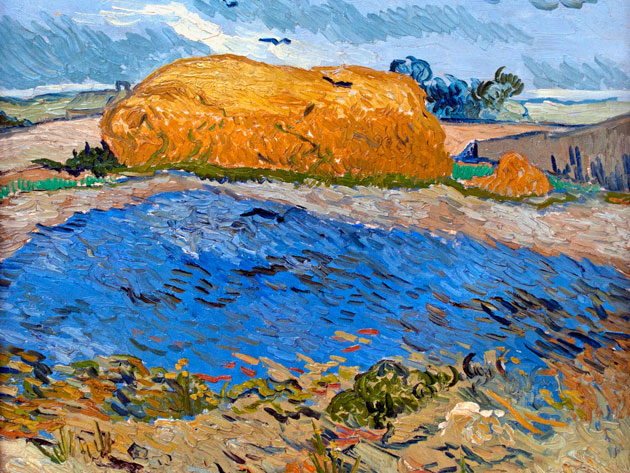Tuesday 30th June 2015
It seems strange to say, but we almost take it for granted that the artworks of the ancient masters are immutable. Certainly, they are subject to the rigours and stresses of time, but usually this presents itself of the form of craquelure (the name given to the intricate network of cracks and splits that occur in oil paintings, most commonly visible in works of the European old masters), slight fading, or something similar that tends to reinforce the sense of gravity and aura that surround the actual paintings themselves. What we don't expect is for the actual pigments themselves to change, beyond natural aging.
This turns out to be exactly what's happening to one of Vincent Van Gogh's masterpieces, entitled 'Wheat Stack Under A Cloudy Sky'. The red pigments Van Gogh used extensively in his work, known as 'red lead' or 'r minium', have been slowly fading away to white, rather than simply losing their lustre and vibrancy as might be expected in the normal aging of paint. Thanks to some new investigative work by researchers at the University of Antwerp using a new X-ray powder diffraction mapping and tomography techniques, they were able to dig down into the cause of the pigmentation shift.
In Chemistry World, Matthew Gunther said "Researchers think that when red lead is exposed to light it is converted into plumbonacrite, which reacts with carbon dioxide to form hydrocerussite and cerussite." For those of us who don't have an advanced chemistry degree (probably most of us ;-) ) that the chemicals used in the pigment are interacting with the carbon dioxide in the air and changing their chemical properties, which in turn changes the pigment towards white.
Alison Meier, an art writer and theorist, speaking about the importance of this finding, said that "continued research on the chemistry of van Gogh's pigments could have a wider influence on art conservation. And importantly, it could influence the way his paintings are displayed in light, knowing that the rare mineral in the red may fade from the colors the artist originally envisioned."
It really starts to raise questions about how long these original masterpieces can be expected to stay true to the original vision of the artist, and how best to preserve them for future generations. While it's a beautiful image to see in a digital reproduction, it's still not quite the same as seeing the original work in all its glory. Hopefully, these discoveries will also shed some light on possible practices for art conservation and preservation, as science and technology advance into uncharted territory.
Posted on June 30th 2015 on 04:03pm
 It seems strange to say, but we almost take it for granted that the artworks of the ancient masters are immutable. Certainly, they are subject to the rigours and stresses of time, but usually this presents itself of the form of craquelure (the name given to the intricate network of cracks and splits that occur in oil paintings, most commonly visible in works of the European old masters), slight fading, or something similar that tends to reinforce the sense of gravity and aura that surround the actual paintings themselves. What we don't expect is for the actual pigments themselves to change, beyond natural aging.
It seems strange to say, but we almost take it for granted that the artworks of the ancient masters are immutable. Certainly, they are subject to the rigours and stresses of time, but usually this presents itself of the form of craquelure (the name given to the intricate network of cracks and splits that occur in oil paintings, most commonly visible in works of the European old masters), slight fading, or something similar that tends to reinforce the sense of gravity and aura that surround the actual paintings themselves. What we don't expect is for the actual pigments themselves to change, beyond natural aging.



